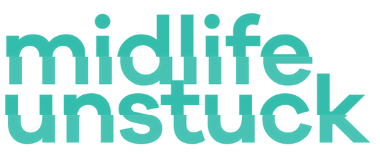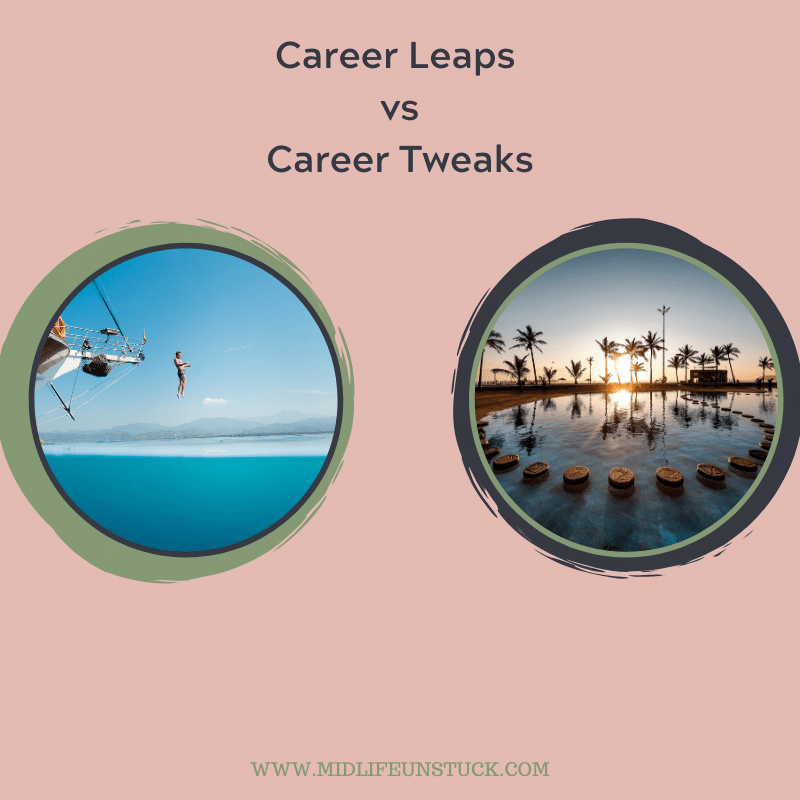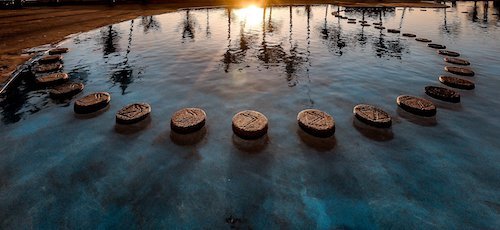Career change in your 40s or 50s: Leaps vs Tweaks (do you really need to escape your first career?)
Designing more satisfaction into your career needn’t involve a scary leap of faith into the unknown. This article compares the pros and cons for two opposing methods of designing more satisfaction and fun into your work.
When potential clients jump on one of my free 30min calls to see if they could work with me, they almost always believe that they need to escape their current career to find happiness.
Sometimes, that is the case.
But more often than not, it’s the fantasy of escape that attracts.
It’s the quick-fix they’re seeking.
That isn’t always the right solution.
I know this because I invested 18 months of precious life time, a large chunk of my savings and half of my sanity escaping to do a full-time MSc in Psychology in my 40s. Had I known then what I know now, I might have done it differently.
But the lure of escape was all-encompassing.
So many of my clients and almost all of the 100+ successful midlife career changers I’ve interviewed for my book research found that making tweaks to their work made a GIANT difference to how they felt about it.
AND those tweaks gave them more time, enhanced energy and extra focus to invest in making their work futures even better than they imagined possible.
I hope after reading this article, you might decide to think hard about HOW you go about your career overhaul.
Leap vs Tweaks.
Broadly, there are two popular methods of designing your future work differently.
Let’s start with Leaping, shall we?
Crikey, taking a career leap and escaping from your current problems looks terribly attractive and exciting…until reality hits.
Taking a career leap - The upsides.
You can escape ‘x’ (whatever it is that’s annoying the hell out of you) and make a nice clean break.
It feels really exciting, possibly even thrilling...like bungee jumping without the safety rope.
The story you tell your friends is concrete and simple...at the beginning.
It feels good to have a plan...any bloody plan.
There will be plenty of surprises...some good.
You’ll gain plenty of admiration from others for having “bravery”(?)…initially…at least.
Taking a career leap - The downsides.
It’s bloody risky...unless you make sure your leap is built on rock solid foundations or you have a gigantic bag of golden coins you don’t mind losing.
It’s financially expensive to make a 100% leap into a world where you are unknown…see above.
It’s emotionally expensive to put all your eggs in one basket…stress is very highly associated with leaping. It brings the uncontainable type of stress that spills over into relationships, family dynamics, love life, parenting behaviour, and physical health!
The story you tell your friends is shrouded in fear of failure…ouch!
It takes longer than you think…most new businesses take up to 3 years before they know if they will be successful.
Surprises are everywhere…the good, the bad, and the ugly kind.
You often have to take work that you don’t enjoy because you have no other choice.
And what about making tweaks?
Making tweaks to your current career and evolving it into a new career might be less exciting. But there’s a great deal less stress, lower risk and higher change of long-term success. Read on for real life examples.
Making tweaks (sometimes before a leap) - The upsides.
You choose the level of risk (personal, financial, reputation, ego, status etc).
You choose timing of investments, experiments and tweaks.
You retain decision-making control…you can say “no” to ideas that don’t feel right.
Fear of failure is much lower…phew!
No design experiment is a failure - just an experiment that needs further tweaking.
It’s excitingly iterative - you’ll be designing, analysing and refining forever.
Your brain will be active all the time, designing new experiments and analysing results.
It’s much less stressful because you haven’t got all your eggs in the one basket. You don’t need to have your fingers and toes crossed all the time…crippling in more ways than one.
You build in time to learn on the way - while still getting paid.
Making tweaks (sometimes before a leap) - The downsides.
The design-analyse-refine model takes longer than a leap. Full stop.
Your brain will be active all the time designing new experiments and analysing results.
It’s annoyingly iterative. You’ll be designing, analysing and refining forever.
If you’re a gambler - it’s not as exciting as leaping.
Your friends won’t be as impressed as it’s a lot less dramatic, less exciting and less gossip-worthy.
You need stamina. And often a partner in design to keep you going. Luckily you know one of those.
It takes longer...but has a much higher success rate.
The surprises are smaller and less dramatic…meaning lower stress levels.
Examples of successful career leaps.*
*that didn’t require A HUGE CASH INJECTION.
Mmmm?
I can’t come up with any - if you can, email me at lucia@midlifeunstuck.com
Career changes that involve a leap into the unknown, without making tweaks first, are far and few between. The internet would have you believe that individuals resign from their first career on a Friday, and hit the jackpot in their second career overnight. It’s a myth.
Examples of successful career change that began with tweaks.*
*and then sometimes involved a little leap.
Kate Gregory: Defence executive to gin maker. Tiny experiment - making the first batch of gin in spare hours - evolved very slowly over the years. She built a bigger gin distillery, a bar, and an events company, all with very limited early funds while in full-time employment.
Andy Eaton: International Finance Director to owner of Successful Accounting Firm. Built over several years, while holding down a part-time role, expanding network, offering services, refining them, and now in the high-growth phase.
Liz Wilson (Ma Baker): Teacher to Micro-Baker. Reduced hours in first career, took a course in micro-baking, used spare time volunteering in bakeries, and baking every minute of the day, until she was making enough to end her first career.
Dan Barker: Engineer to Industrial Photographer. Left full-time work to earn more contracting while paying off family debt. Photographed for small fees in spare time. Self-taught photography. Bought bits and pieces. Recently made move to full-time photographer and thriving.
Claire Grove: Mum to Fashion Influencer, Illustrator and Author. Started with kitchen table drawings, that turned into a self-published book, which turned into a regular column in women’s magazine and being paid by brands to influence her followers to buy their products.
Andrea Mara: Financial Services career to full-time Author. Started writing a blog while in full-time work, learned what worked and what didn’t, wrote more, made redundant, designed a 6 month experiment to see if she could make enough money. She could. Got her first book deal.
Duncan Haddrell: FD to owner of Distribution Business. Tried lots of different businesses in the finance leadership team, decided he would own his own business one day, moved out of London to reduce spending and increase saving, reviewed lots of businesses over many years until found the right one.
There’s plenty more where they came from…
Only a few of the 100+ interviews that spawned my book X Change: How to torch your work treadmill (Here it is on audible) involved a jump into a completely new industry - but all involved multiple tweaks before the jump.
Absolutely zero leaps of faith.
It’ll come as no surprise that I recommend active, deliberate tweaking as the best strategy to design more happiness and satisfaction into work - unless you have an endless giant bag of gold to spend!
If you’re thinking of making some changes to your work situation, the best place to start is figuring out what you uniquely have to offer the world. I call these your Superpowers.
In both my one-to-one programmes, I help you find your Superpowers. In the Speedy Sherpa version, I do the hard work for you.
Knowing your Superpowers provides you with the rock solid framework upon which to arange your tweaks and experiments.
It’s the quickest way I’ve found to reduce the risk around designing your future career.
Read the unedited reviews of clients who’ve worked with me one-to-one here.











